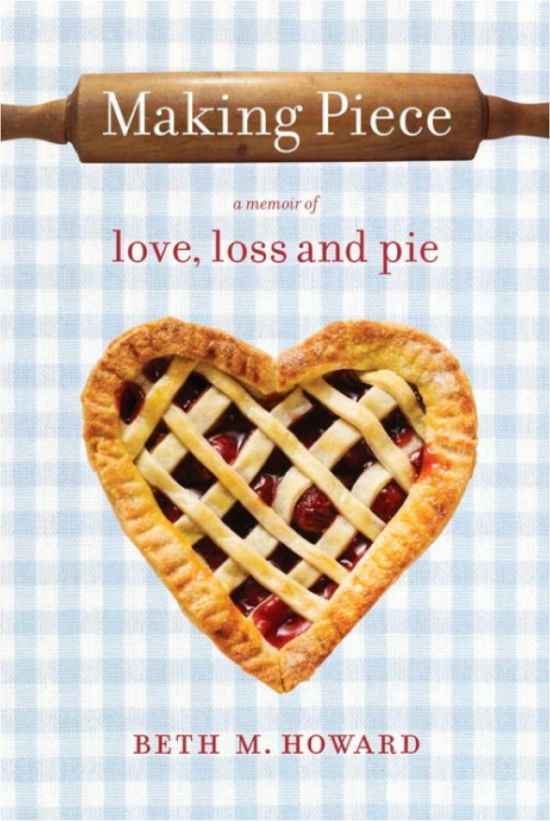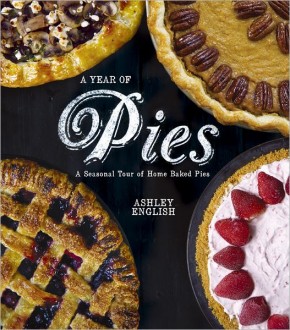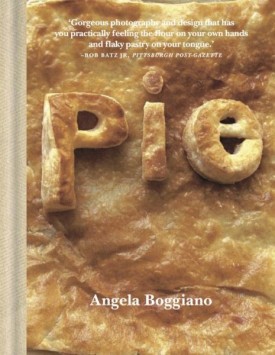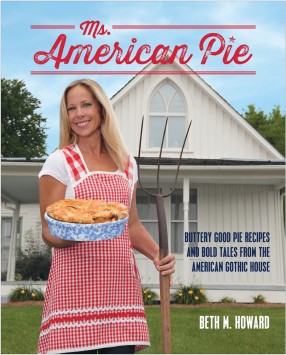Making PieceA Memoir of Love, Loss and Pies
When journalist Beth M. Howard’s young husband dies suddenly, she packs up the RV he left behind and hits the American highways. At every stop along the way—whether filming a documentary or handing out free slices on the streets of Los Angeles—Beth uses pie as a way to find purpose.
When journalist Beth M. Howard’s young husband dies suddenly, she packs up the RV he left behind and hits the American highways. At every stop along the way—whether filming a documentary or handing out free slices on the streets of Los Angeles—Beth uses pie as a way to find purpose. Howard eventually returns to her Iowa roots and creates the perfect synergy between two of America’s greatest icons—pie and the American Gothic House, the little farmhouse immortalized in Grant Wood’s famous painting, where she now lives and runs the Pitchfork Pie Stand.
Making Piece powerfully shows how one courageous woman triumphs over tragedy. This beautifully written memoir is, ultimately, about hope. It’s about the journey of healing and recovery, of facing fears, finding meaning in life again, and moving forward with purpose and, eventually, joy. It’s about the nourishment of the heart and soul that comes from the simple act of giving to others, like baking a homemade pie and sharing it with someone whose pain is even greater than your own. And it tells of the role of fate, second chances and the strength found in community.
Beth M. Howard is a journalist, blogger and pie baker. Her articles have appeared in Elle, Shape, Travel + Leisure and Natural Health, among many other publications. In 2001, at the height of the dot com boom, she quit a lucrative web producing job in San Francisco to bake “pies for the stars” at a gourmet deli in Malibu, California. Her blog, www.TheWorldNeedsMorePie.com, which she launched in 2007, regularly receives national press that has included Better Homes and Gardens, the New York Times and NPR’s Weekend Edition. Beth lives in Eldon, Iowa, in the famous American Gothic House.
WWW.TheWorldNeedsMorePie.com
Beth M. Howard author of Making Piece: A Memoir of Love Loss and Pie, talks to us about a number of things including butter, the magic of pie and Grant Wood.
What makes a good pie?
In one word: butter. A crust made with butter tastes best. Also fresh ingredients. You want to use fresh, ripe fruit. My favorite pies are the ones where I pick the fruit myself. And love. Anything made by hand with love and care and the intention to be shared is a good pie. I’ve been a pie judge at the Iowa State Fair and I know what makes a bad pie: artificially flavored instant Jell-O used as a thickener for a fresh peach pie. Just say no to that.
What is it about pie that has such a special effect on people?
People get too busy to make homemade desserts, so anytime someone shows up at a dinner party with a homemade pie others are impressed. “You MADE that?” they say, incredulous. Pie is this thing that gets shared. It brings people together. It reminds people of their grandmothers. It represents simplicity. I could go on and on about how special pie is, and the magical powers it holds. My favorite story is the one about how my mother made my dad his favorite pie — banana cream — when they were dating. That pie, all creamy and gooey and delicious, prompted him to propose to her. Now that’s a special effect!
You truly believe in pie. You recently went to Newtown Connecticut to give out free pie. What was that experience like?
I’m still trying to process the experience. In the first place, it was such a spontaneous idea to go. I posted a comment on Facebook the night of the tragedy saying something like, “If packing up my RV with my pie supplies and making pies to give away would help ease the grief of those people in Newtown I would start driving now.” Within seconds I had people offering to chip in for gas, pay for ingredients and one friend from high school, Michael Nahra, offered to come along and help me drive. I left early the very next morning. Another friend from New Jersey, Janice Molinari who is featured in my book MAKING PIECE: A MEMOIR OF LOVE, LOSS AND PIE, immediately organized her neighbors in a pie-making marathon. By the time we reached Janice’s house on Sunday afternoon there were 60 people working in six different kitchens on her block. About 150 pounds of apples had been peeled and pies were already going into the ovens. We baked the entire next day as well and loaded 240 apple pies into the RV to take to Newtown. What was incredible is the way people reached out and wanted to help. So many friends and even strangers were emailing and calling and wanting to volunteer, to either make pie or help serve it. Sometimes they just showed up. One friend, Wendy Custer who I hadn’t seen since eighth grade, flew up from Georgia. A friend of a friend drove from 3-1/2 hours away with her 15-year-old daughter. This kind of outpouring of support was so moving. Then, once we got to Newtown, what was equally remarkable is how welcoming the residents were, how much they appreciated our pie and our presence, and how gracious and positive they were in the face of such horrific circumstances. We set up our folding tables in several locations, handing out free slices at the Newtown Youth Academy and in front of Edmond Town Hall next to one of the outdoor memorials. We delivered whole pies to the police department, the funeral homes and to the Board of Education. Everywhere we went we were able to make people smile, all because of homemade apple pie. Of course we both saw and shed many tears too. All of us serving the pie would burst into tears at various times, especially when a funeral procession would pass. It was both heart wrenching and heartwarming to be there. It’s an experience that will take me a long time to process and understand. All I can really grasp so far is that I left with a lot of new friends and an invitation to return. I’m going back the first week of March to teach pie classes to the community. I know how making and sharing pie helped me get through my own grief — not just the tactile experience of creating something but the joy pie brings to others when shared — so I just hope that my lessons can be passed on to those in Newtown who are grieving, who need a way to heal. Even if I can ease someone’s pain for the amount of time it takes to make a pie, then I feel like I’ve contributed something meaningful to society.
Can you tell us a little about the Pitchfork Pie Stand?
You want me to tell you about that nightmare? (Ha ha!) About what it’s like to make 100 pies a weekend in a tiny, sweltering, smoky kitchen with just one small oven? And how I let tourists come into my house to buy the pie? How I drive 90 miles every week for supplies and then haul 50-pound sacks of flour and sugar up and down my stairs? About my weekly scavenger hunt around Southeast Iowa to find ripe fruit? About the oven burns covering my forearms? I really don’t know how I got myself into this mess, but people LOVE it! Last summer I had people drive 700 miles just to come to my pie stand! I’ve been featured on CBS This Morning, Real Simple, The Atlantic and the front page of the Los Angeles Times, to name just a sampling of the national press I’ve received for the pie stand. I keep saying I’m not going to do it again, but I’m already getting inquiries about my hours for this coming summer, so what can I do? Hire more help, that’s what! I always dreamed of opening a pie shop and when I moved into the American Gothic House I thought, well, why not just run a pie stand? That’s perfect for me; I can spend my winters, when it’s quiet here, writing my books and my summers, when the tourists come in large numbers, baking. I never dreamed the pie stand would be so successful and so busy. I would never survive if it was a year-round business. And even though I burn out on it by Labor Day, after having a few months’ rest I find myself thinking about it and am ready to open up again by Memorial Day. I’ve learned a few lessons. I keep the choices to a minimum — it’s usually just apple, apple crumble, peach, and blueberry. Really, whatever is in season. And I do not take special orders. For example, we don’t make gluten free pie and we won’t make a special strawberry pie with organic whipped cream for Janie’s birthday party. So don’t ask. In spite of getting totally stressed and exhausted, I’m actually pretty nice to the customers.
You are an experienced writer. But you really put your self out there in this book. What was the writing process like for this book?
I’m glad I had the chance to write this book. It was a cathartic experience for me in working through and then shedding the deeper layers of my grief and guilt. I’m proud of how honest I was in telling my story. Not everyone agrees with that though. My dad said he was going to tell his friends it was fiction. I laugh because it says “memoir” right in the title. I had already been blogging about my grief in real-time, and I had gotten such positive feedback about my raw honesty there, so it wasn’t really a stretch to continue writing in the same forthcoming way in my book. What I remember about the process is that I started writing the book in January when it was bitter cold and snowy in Iowa. I moved my laptop to my kitchen table — interestingly, the same place I make my pies — put a heat dish underneath, and almost never bothered to get dressed. I stayed in my fleece bathrobe and sheepskin boots and just wrote and wrote and wrote. It does help to live in a place free of distractions as there were no temptations — let alone invitations — to go out for lunch or meet a friend for a glass of wine. I learned that I have the discipline, the “sitzfleisch,” to complete a book-length work. Which means there’s no excuse for not writing another one.
Can you tell us a little about your house?
I live in one of the cutest and most affordable houses in the country. It also happens to be one of the most famous. And most remote. You might not know it exists and if you are like me you won’t even know the artist’s name, but I live in the American Gothic House, the little white farmhouse with the church-like window, that appears in the background of the iconic painting by…yes, that would be Grant Wood (not Norman Rockwell, ahem!). It’s located in rural Southeast Iowa, in a former railroad town called Eldon (population 928), where there’s no grocery store and the idea of dining out is going to the bar for a breaded pork tenderloin the size of a dinner plate. I’ve lived here for two and a half years now, though when I first inquired about renting it I asked if I could get a three-month lease. I never expected to live here so long — and to like it so much. I also like my rent. It’s $250 a month. The reason it’s so cheap, my landlord says, is “because of the obvious hassles.” It’s a tourist attraction (owned by the State Historical Society of Iowa) and there is no signage to inform people it’s a private residence. So occasionally people will press their faces up to my windows trying to get a glimpse inside. Once someone saw me getting out of the shower. Boy, were they surprised! I keep my curtains shut more often than I used to. But really, it’s fun to live here. I wonder if I lived further out in the country, on a farm where no tourists ever passed by, if I would feel too isolated. One of the things that makes it so interesting to live here is meeting people from all over the world. If the visitor center next door is closed and I’m feeling the need to have human contact, I can just go outside and offer to take their picture — and loan them my pitchfork. Not to mention, the house is an ideal location for a pie stand.
What are you working on now?
I’ve been trying to get started on another book — since winter is my window of time for writing — but that isn’t going so well. I think, in part, because I’m still keyed up from going to Newtown. So now I’m working on airline reservations, trying to get some time away from this cold weather. I’m also teaching pie classes in the American Gothic House, as well as working on getting pie classes scheduled in Newtown for my return there in March. And Christmas cards. I’m still writing Christmas cards.
Recipes: Shaker Lemon Pie, Basic Pie Crust
Shaker Lemon Pie
I’ve been touting this pie during my book tour and continue to get requests for the recipe. So, my dear pie lovers, here it is. And it’s EASY!
2 large lemons (Meyer lemons if you can find them, but works with any kind)
2 cups sugar
1/4 teaspoon salt
4 eggs (eaten)
3 tablespoons flour
Dough for one double-crust pie (crust recipe below)
Wash and dry whole lemons. Using a mandoline (serrated knife works too), slice lemons paper thin into a large bowl. (Remove seeds.) Stir in sugar, cover, and set aside at room temperature overnight.
Mix lemon-sugar mixture with beaten eggs, salt and flour. Pour in pie shell. Cover with top crust, brush with beaten egg, poke with vent holes.
Bake at 425°F. for 20 minutes. Reduce the temperature to 375°F. and bake for 25 to 30 minutes more.
Basic Pie Crust
2-1/2 cups flour
1/2 cup butter
1/2 cup Crisco
Dash of salt
Ice water (fill one cup but use only enough to moisten dough)
In a deep bowl, work the butter and shortening into the flour with your hands until you see marble-sized lumps form. Add ice water a little at a time, sort of “fluffing” the flour. When the dough feels moistened enough do a “squeeze test” and when it holds together you’re done. Do not overwork the dough! It takes very little time and you’ll be tempted to keep touching it, but don’t! Now divide the dough in two, form each half into a disk shape and roll flat and thin to fit your pie dish. Sprinkle flour under and on top of your dough to keep it from sticking to your rolling surface. Trim excess dough to about 1 inch from the dish edge with a scissors.











Leave a Reply